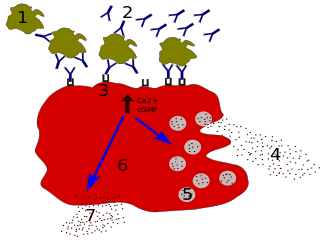Related Research Articles

Immunoglobulin G (IgG) is a type of antibody. Representing approximately 75% of serum antibodies in humans, IgG is the most common type of antibody found in blood circulation. IgG molecules are created and released by plasma B cells. Each IgG antibody has two paratopes.

Plasma cells, also called plasma B cells or effector B cells, are white blood cells that originate in the lymphoid organs as B cells and secrete large quantities of proteins called antibodies in response to being presented specific substances called antigens. These antibodies are transported from the plasma cells by the blood plasma and the lymphatic system to the site of the target antigen, where they initiate its neutralization or destruction. B cells differentiate into plasma cells that produce antibody molecules closely modeled after the receptors of the precursor B cell.

Cluster of differentiation 40, CD40 is a type I transmembrane protein found on antigen-presenting cells and is required for their activation. The binding of CD154 (CD40L) on TH cells to CD40 activates antigen presenting cells and induces a variety of downstream effects.
Co-stimulation is a secondary signal which immune cells rely on to activate an immune response in the presence of an antigen-presenting cell. In the case of T cells, two stimuli are required to fully activate their immune response. During the activation of lymphocytes, co-stimulation is often crucial to the development of an effective immune response. Co-stimulation is required in addition to the antigen-specific signal from their antigen receptors.

CD22, or cluster of differentiation-22, is a molecule belonging to the SIGLEC family of lectins. It is found on the surface of mature B cells and to a lesser extent on some immature B cells. Generally speaking, CD22 is a regulatory molecule that prevents the overactivation of the immune system and the development of autoimmune diseases.

Degranulation is a cellular process that releases antimicrobial cytotoxic or other molecules from secretory vesicles called granules found inside some cells. It is used by several different cells involved in the immune system, including granulocytes and mast cells. It is also used by certain lymphocytes such as natural killer (NK) cells and cytotoxic T cells, whose main purpose is to destroy invading microorganisms.
Priming is the first contact that antigen-specific T helper cell precursors have with an antigen. It is essential to the T helper cells' subsequent interaction with B cells to produce antibodies. Priming of antigen-specific naive lymphocytes occurs when antigen is presented to them in immunogenic form. Subsequently, the primed cells will differentiate either into effector cells or into memory cells that can mount stronger and faster response to second and upcoming immune challenges. T and B cell priming occurs in the secondary lymphoid organs.

Marginal-zone B cells are noncirculating mature B cells that in humans segregate anatomically into the marginal zone (MZ) of the spleen and certain other types of lymphoid tissue. The MZ B cells within this region typically express low-affinity polyreactive B-cell receptors (BCR), high levels of IgM, Toll-like receptors (TLRs), CD21, CD1, CD9, CD27 with low to negligible levels of secreted-IgD, CD23, CD5, and CD11b that help to distinguish them phenotypically from follicular (FO) B cells and B1 B cells.
Cruzipain is a cysteine protease expressed by Trypanosoma cruzi.
The immune repertoire encompasses the different sub-types an organism's immune system makes of immunoglobulins or T-cell receptors. These help recognise pathogens in most vertebrates. The sub-types, all differing slightly from each other, can amount to tens of thousands, or millions in a given organism. Such a wide variety increases the odds of having a sub-type that recognises one of the many pathogens an organism may encounter. Too few sub-types and the pathogen can avoid the immune system, unchallenged, leading to disease.
Regulatory B cells (Bregs or Breg cells) represent a small population of B cells that participates in immunomodulation and in the suppression of immune responses. The population of Bregs can be further separated into different human or murine subsets such as B10 cells, marginal zone B cells, Br1 cells, GrB+B cells, CD9+ B cells, and even some plasmablasts or plasma cells. Bregs regulate the immune system by different mechanisms. One of the main mechanisms is the production of anti-inflammatory cytokines such as interleukin 10 (IL-10), IL-35, or transforming growth factor beta (TGF-β). Another known mechanism is the production of cytotoxic Granzyme B. Bregs also express various inhibitory surface markers such as programmed death-ligand 1 (PD-L1), CD39, CD73, and aryl hydrocarbon receptor. The regulatory effects of Bregs were described in various models of inflammation, autoimmune diseases, transplantation reactions, and in anti-tumor immunity.

ILC2 cells, or type 2 innate lymphoid cells are a type of innate lymphoid cell. Not to be confused with the ILC. They are derived from common lymphoid progenitor and belong to the lymphoid lineage. These cells lack antigen specific B or T cell receptor because of the lack of recombination activating gene. ILC2s produce type 2 cytokines and are involved in responses to helminths, allergens, some viruses, such as influenza virus and cancer.
Tolerogenic dendritic cells are heterogenous pool of dendritic cells with immuno-suppressive properties, priming immune system into tolerogenic state against various antigens. These tolerogenic effects are mostly mediated through regulation of T cells such as inducing T cell anergy, T cell apoptosis and induction of Tregs. Tol-DCs also affect local micro-environment toward tolerogenic state by producing anti-inflammatory cytokines.

Uterine natural killer cells make up approximately 70% of maternal lymphocytes during pregnancy, occupying both the decidua basalis of the endometrium at the implantation site and the mesometrial lymphoid aggregate of pregnancy (MLAp) that surrounds the blood vessels supplying the placenta. This number is at its peak in early pregnancy but declines at parturition.
Karen Louise Mossman is a Canadian virologist who is a professor of Pathology and Molecular Medicine at McMaster University. Mossman looks to understand how viruses get around the defence mechanisms of cells. She was part of a team of Canadian researchers who first isolated SARS-CoV-2.

Jessica Geraldine Borger is an Australian T Cell immunologist, lecturer and graduate course coordinator at the Central Clinical School, Monash University. Her research has added to the understanding of the molecular mechanisms of T cell function. Additionally, Borger is a news and commentary editor for Immunology & Cell Biology and a guest associate editor for Frontiers in Immunology, and a reviewer for several academic journals. Jessica also advocates for gender equality in science, technology, engineering and mathematics (STEM) in her position a member of the Gender Equity, Diversity and Inclusion committee of the Central Clinical School at Monash University.

Eat-me signals are molecules exposed on the surface of a cell to induce phagocytes to phagocytose (eat) that cell. Currently known eat-me signals include: phosphatidylserine, oxidized phospholipids, sugar residues, deoxyribonucleic acid (DNA), calreticulin, annexin A1, histones and pentraxin-3 (PTX3).
Cd1-restricted T cells are part of the unconventional T cell family, they are stimulated by exposure to CD1+ antigen presenting cells (APCs). Many CD1-restricted T cells are rapidly stimulated to carry out helper and effector functions upon interaction with CD1-expressing antigen-presenting cells. CD1-restricted T cells regulate host defence, antitumor immunity and the balance between tolerance and autoimmunity.
Thymus stromal cells are subsets of specialized cells located in different areas of the thymus. They include all non-T-lineage cells, such as thymic epithelial cells (TECs), endothelial cells, mesenchymal cells, dendritic cells, and B lymphocytes, and provide signals essential for thymocyte development and the homeostasis of the thymic stroma.
Interleukin 15-like (IL-15L) is an interleukin, a type of cytokine signaling in the immune system. It is a secreted protein of approximately 120 amino acids and related to IL-2 and IL-15.
References
- ↑ Stewart, Alexander; Sinclair, Emma; Ng, Joseph Chi-Fung; O’Hare, Joselli Silva; Page, Audrey; Serangeli, Ilaria; Margreitter, Christian; Orsenigo, Federica; Longman, Katherine; Frampas, Cecile; Costa, Catia; Lewis, Holly-May; Kasar, Nora; Wu, Bryan; Kipling, David (2022). "Pandemic, Epidemic, Endemic: B Cell Repertoire Analysis Reveals Unique Anti-Viral Responses to SARS-CoV-2, Ebola and Respiratory Syncytial Virus". Frontiers in Immunology. 13. doi: 10.3389/fimmu.2022.807104 . ISSN 1664-3224. PMC 9111746 . PMID 35592326.
- ↑ "Studies on the human glutathione peroxidase gene and related DNA sequences | WorldCat.org". www.worldcat.org. Retrieved 1 January 2023.
- ↑ "Prof Deborah Dunn-Walters | University of Surrey". www.surrey.ac.uk. Retrieved 1 January 2023.
- ↑ Stewart, Alexander; Ng, Joseph Chi-Fung; Wallis, Gillian; Tsioligka, Vasiliki; Fraternali, Franca; Dunn-Walters, Deborah K. (2021). "Single-Cell Transcriptomic Analyses Define Distinct Peripheral B Cell Subsets and Discrete Development Pathways". Frontiers in Immunology. 12. doi: 10.3389/fimmu.2021.602539 . ISSN 1664-3224. PMC 8012727 . PMID 33815362.
- 1 2 Wu, Yu-Chang; Kipling, David; Leong, Hui Sun; Martin, Victoria; Ademokun, Alexander A.; Dunn-Walters, Deborah K. (19 August 2010). "High-throughput immunoglobulin repertoire analysis distinguishes between human IgM memory and switched memory B-cell populations". Blood. 116 (7): 1070–1078. doi:10.1182/blood-2010-03-275859. ISSN 0006-4971. PMC 2938129 . PMID 20457872.
- ↑ Dunn-Walters, D K; Isaacson, P G; Spencer, J (1 August 1995). "Analysis of mutations in immunoglobulin heavy chain variable region genes of microdissected marginal zone (MGZ) B cells suggests that the MGZ of human spleen is a reservoir of memory B cells". The Journal of Experimental Medicine. 182 (2): 559–566. doi:10.1084/jem.182.2.559. ISSN 0022-1007. PMC 2192131 . PMID 7629512.
- ↑ Gibson, Kate L.; Wu, Yu‐Chang; Barnett, Yvonne; Duggan, Orla; Vaughan, Robert; Kondeatis, Elli; Nilsson, Bengt‐Olof; Wikby, Anders; Kipling, David; Dunn‐Walters, Deborah K. (February 2009). "B‐cell diversity decreases in old age and is correlated with poor health status". Aging Cell. 8 (1): 18–25. doi:10.1111/j.1474-9726.2008.00443.x. ISSN 1474-9718. PMC 2667647 . PMID 18986373.
- ↑ Stewart, Alexander; Ng, Joseph Chi-Fung; Wallis, Gillian; Tsioligka, Vasiliki; Fraternali, Franca; Dunn-Walters, Deborah K. (2021). "Single-Cell Transcriptomic Analyses Define Distinct Peripheral B Cell Subsets and Discrete Development Pathways". Frontiers in Immunology. 12. doi: 10.3389/fimmu.2021.602539 . ISSN 1664-3224. PMC 8012727 . PMID 33815362.
- ↑ Wu, Yu-Chang Bryan; Kipling, David; Dunn-Walters, Deborah (2011). "The Relationship between CD27 Negative and Positive B Cell Populations in Human Peripheral Blood". Frontiers in Immunology. 2: 81. doi: 10.3389/fimmu.2011.00081 . ISSN 1664-3224. PMC 3341955 . PMID 22566870.
- ↑ Margreitter, Christian; Lu, Hui-Chun; Townsend, Catherine; Stewart, Alexander; Dunn-Walters, Deborah K; Fraternali, Franca (14 April 2018). "BRepertoire: a user-friendly web server for analysing antibody repertoire data". Nucleic Acids Research. 46 (W1): W264–W270. doi:10.1093/nar/gky276. ISSN 0305-1048. PMC 6031031 . PMID 29668996.
- ↑ Ng, Joseph CF; Garcia, Guillem Montamat; Stewart, Alexander T.; Blair, Paul; Dunn-Walters, Deborah K.; Mauri, Claudia; Fraternali, Franca (2023). "sciCSR infers B cell state transition and predicts class-switch recombination dynamics using single-cell transcriptomic data" (PDF). bioRxiv Preprint. doi:10.1101/2023.02.02.526789. PMID 37932398. S2CID 256617391.
- ↑ "CARINA Network". British Society for Immunology. Retrieved 30 November 2023.
- ↑ "New network to boost understanding of immune system and ageing | University of Surrey". www.surrey.ac.uk. Retrieved 1 January 2023.
- 1 2 "expert reaction to JCVI advice on COVID-19 vaccines for the autumn booster programme | Science Media Centre" . Retrieved 1 January 2023.